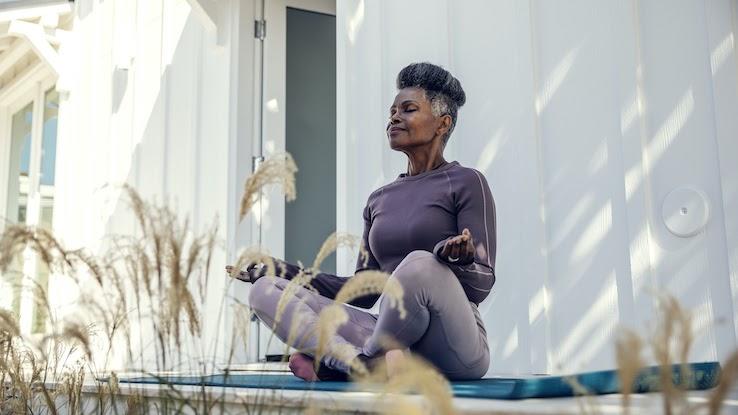
Simple Mindfulness Meditation Exercises for Beginners
With everything you’re juggling in your daily life, it’s easy to feel a little off balance from time to time. From managing mishaps at work to making sure your spouse, kids, pets and hopefully yourself are all taken care of, it can feel like a luxury to stop and take a breath for a moment. But doing so in an intentional way — by practicing mindfulness meditation — may end up being one of the best decisions you make for your mental and physical health.
From lowering stress and anxiety to helping you get more sleep, there are plenty of ways meditation can help — and plenty of reasons why it’s been practiced for centuries. But it can sound deceptively simple. Read on to learn more about mindfulness meditation and some helpful ways you can start incorporating this practice into your life with ease.
What Is Mindfulness Meditation?

Meditation is an ancient Buddhist tradition that focuses on clearing your mind — you can think of meditation as training for your brain in the same way exercise trains your physical body. Just as there are different workouts you can engage in to get your body fit, there are different types of meditation you can utilize to sharpen your mind. One of these types is mindfulness meditation.
Like its name suggests, this meditation involves becoming more mindful of the feelings you’re experiencing and the sensations your body is going through. But, instead of getting to the root of these feelings or actively analyzing them, you simply let yourself feel them without being judgmental about them or trying to figure out what they mean. Your goal is to become mindful of the present moment and aware of what’s going on around you so that you’re ultimately less reactive to or overwhelmed by what you’re feeling — particularly when it comes to things like stress and anxiety.
The Benefits of Mindfulness Are Numerous

While meditation may have once seemed like an esoteric practice whose measurable benefits were questionable (or at least unknown), it’s undergone numerous clinical studies that are cluing scientists into the very real benefits this practice has. As it turns out, meditation is officially great for your mind and body.
When it comes to the science behind meditation, different studies have investigated its relationship to a variety of different health conditions. While research remains ongoing, so far it’s demonstrated evidence that meditation may promote an array of positive health effects, including:
- A natural reduction in pain levels
- Lower blood pressure in people who are at risk of developing high blood pressure
- “Help with psychological distress, anxiety, depression, anger/hostility and coping ability,” according to the U.S. Department of Health and Human Services
- Potential diminishing severity of irritable bowel syndrome symptoms after at least eight weeks of practice
- Improved sleep for people with insomnia
- Enhanced self-esteem
- Possible reduction of widespread body inflammation
- Better immune system functioning
On another practical level, meditation helps your body — even your nervous system — relax. Other potential benefits of meditation and the relaxation it induces include the following:
- Your ability to relax has a profound effect on your bodily functions, and the relaxation meditation leads to can lower your blood pressure, improve circulation and lower your heart rate. You could see less perspiration, less strain in your breathing and lower levels of stress hormones in your body.
- One of the biggest benefits of meditation is mental. Being mindful can reduce your stress levels and anxiety and make you feel more relaxed. Regular mindfulness meditation becomes a tool you can use throughout your life to boost your mental and physical wellness.
- For many people, meditation is a spiritual practice. It can allow you to feel closer to a higher power and more connected to your faith. This transcendent state feels otherworldly.
- Meditation may also help kids learn to become more grounded and stable, too, and you can begin practicing mindfulness meditation with your kids. Children benefit from the act of relaxing and concentrating. Practicing mindfulness can help them with their emotions, stress, anxiety and feelings, just as it can for adults. Life is full of new feelings for children, and you may see an improvement in your child’s wellbeing after introducing meditation.
People meditate for different reasons. While some do it as a religious practice, others practice for self-development or a better sense of clarity. Many hope to feel more balanced and relaxed by lowering their stress levels. Whatever your reason, start by trying a few techniques to see which works best for you. Remember to give it time and have patience.
Mindfulness Exercises for Beginners

Mindfulness meditation allows us to embrace wandering thoughts that come into our brains at all times. Whether your mind is running through to-do lists or old memories, the practice of mindfulness encourages you to observe and embrace the thoughts that creep in, even if they’re unpleasant or intrusive.
Often, these types of thoughts can trigger your brain’s stress responses. However, mindfulness counteracts this by activating your brain’s relaxation response, effectively “retraining” your brain not to become stressed by those thoughts any longer. According to the University of Minnesota, “this response engages the parasympathetic nervous system, which is responsible for restoring the body to base levels after a stress response, calming it down by lowering the heart and respiratory rate, blood pressure, and muscle tension.”
Let’s say you’re trying to clear your mind and relax. As you do so, you remember you need to take out the garbage. Over time, you’ll begin to recognize how this makes you feel. You may feel stressed by this thought or worried about everything on your plate. The point of meditation isn’t to focus and analyze the different thoughts, but more to recognize the feelings. Mindfulness means embracing your thoughts, worries and emotions to create better balance in your life. Get started by trying these helpful techniques.
Concentration Meditation
For beginners, concentration meditation is often a good place to start. This practice involves focusing on one single thing, often your breaths. Sit in a comfortable position that supports your body and provides stability. Let your gaze drop downward or close your eyes — whatever feels most comfortable for you. For a few minutes, only focus on physical sensations in your body; people often turn their attention to their breathing patterns.
Your mind may start to wander away from your focus on physical sensations, and that’s okay. When you notice a thought pop into your head, acknowledge it and gently redirect yourself back to your breathing. It’s okay to start off slowly in practicing this type of meditation; even a minute or two can be beneficial. Eventually, you may be able to practice for longer durations. The goal here is to improve your clarity and ability to focus.
Moving Meditations
If you find that you want to incorporate some activity into your meditation, consider trying moving meditation. Many people use walking meditation to reshape their focus. This can be somewhat different from seated concentration meditation because you’ll start by focusing on a variety of things in succession.
You might start out by turning your attention to your breath, but you can also think about the sensations of your feet rising and dropping. After a few minutes of that, you might then take note of the sounds you’re hearing outdoors and then the scents you’re inhaling. Again, if your mind wanders, that’s okay. Simply bring your focus back to the sensations you’re experiencing in the present moment from the world around you to maintain your mindfulness. When you’re ready to stop, pause and intentionally end the session mentally, even if you plan to continue walking.
Resource Links:
https://www.mindful.org/how-to-meditate/
https://www.nccih.nih.gov/health/meditation-in-depth
https://newsnetwork.mayoclinic.org/discussion/mayo-mindfulness-meditation-is-good-medicine/
https://www.takingcharge.csh.umn.edu/how-does-mindfulness-work





